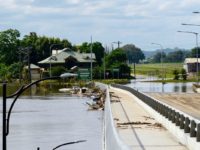My family lives on a property with beautiful views of the Barron River in Cairns, and we also adjoin Thomatis Creek. We run our motorcycle tour business from home. While the property is idyllic for 360 days of the year, it can turn into a monster when it rains.
My heart is genuinely sympathetic with those in the more southern states that are underwater right now; I’m not pointing fingers, just offering some tips that I found helpful.
Unless you’ve been through a flood before, you will not know just how fast it can all happen. There is no time to prepare once the evacuation alarm has been sounded. That alarm only comes when it’s your last chance to get out!
1. Identify your risk and the probability of an occurrence
If your business is near water, you should check with your local council to seek historical data on flood events. The Bureau of Meteorology is also a great source of historical information. Find the biggest flood heights from the past and prepare for that mark to go higher.
Mark your wall, look at everything below the flood height, and ask yourself if it can survive water inundation. Start working toward moving things around now. Live by the idea that a flood is coming every year and live like that. It makes things so much quicker if the alarm is raised.
How often will it happen? There’s much talk about the 1 in 100-year event. Don’t be fooled; a flood can occur every year. We’ve lived on this property for ten years and had our first flood in the first year. We had a five-year break and became complacent, then we had a flood every year for three years in a row, and in one of those years, we had two in the same season.
2. Create your own warning system
During our first flood, I did not know that we could plot the heights of our rivers on the Bureau of Meteorology’s website. The data is all there to be found. So after our second flood, I decided to create a warning system that was individual to our location.
I picked a BoM plot site upstream and downstream from us and photographed the riverbank at each new height. We now know precisely when to move and how much time we have.
3. Preventative measures
Move the office to the highest place possible. We sacrifice some living space to protect our administration from a flood event.
If you are somewhat lazy with backing up your computer, then schedule it to be done at the beginning of each wet season. Better still, move into a cloud-based system to protect the data and think paperless as well.
Another handy thing to do is to photograph every room. If I asked you now to list “all” of your assets; could you? An insurance company will ask for this list after any event. The photographs make it an easy, stress-free process.
Investigate getting some gel sandbags in advance for all doors, these can be used repeatedly. There is no fun in filling sandbags in the rain, it uses up precious time and they’re a one-off use.
When the water is coming, put anything on the ground, up onto tables and benchtops, pull the bottom drawers out, and put them on the bench. Check that any poisons are well above flood levels. Take photographs of your effort for your insurance company.
The last thing to do is turn off all power and pull the fuses; this can help with short-circuiting during the event. Ensure that heavy appliances are secured; it’s amazing what water can move.
Best of luck, I hope this helps.















